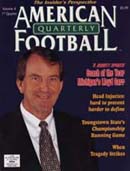Article CategoriesAFM Magazine
|
Clock ManagementKeep hope alive - With a Downfield Lateralby: John T. Reed Author, Football Clock Management © More from this issue A year ago, I wrote a book called Football Clock Management. In the course of writing it, I did a great deal of research. One category of that research was games that were won in dramatic fashion in the final seconds. That category contains a surprising number of downfield-lateral plays-although fewer in recent years than in the past. It should not be that way. In fact, there should be infinitely more downfield laterals in today's football games. The most famous downfield-lateral play in football history was Cal's five-lateral game-winning kick return in the 1982 Big Game against Stanford. That sequence actually involved a cornucopia of clock management mistakes by Stanford. Cardinal quarterback John Elway called his fourth-down field goal timeout with :08 left in the game. He should have waited until the clock wa....The full article can only be seen by subscribers.
|
|
|||||||
| HOME |
MAGAZINE |
SUBSCRIBE | ONLINE COLUMNISTS | COACHING VIDEOS |
Copyright 2025, AmericanFootballMonthly.com
All Rights Reserved





